|
|
The Pecos classification begins with the Basketmaker I Period. Scientists included this period into the classification because they were convinced they would discover remains of this period. Apparently no remains of such a culture have been found yet, so scientists postulate that this culture refers to the Archaic Cultures, which probably were the ancestors of the Anasazi.
The Basketmaker II Period began at about 1 A. D. and lasted until 500 A. D., depending on the region. This culture is the first culture for which there is evidence. The Basketmaker II people mostly lived in caves or rock shelters, sometimes, though, constructed circular log houses. These circular log houses were not widespread, so scientists believe that Basketmaker II people mainly lived in caves or rock shelters. In order to make their home more comfortable, they lined the back of the caves with "soft" material such as leaves or shredded cedar bark. Then they built a sort of windbreak, piling up rocks or leaning up skin and blanket covered poles against the back of the cave. These shelters are sometimes referred to as "nests", as they show some traits of a real nest.

11 In nests at the back of the caves Basketmaker II people seem to have taken shelter.
Although the Basketmaker II people do not appear to have had a true house, they certainly did construct some caches or storage pits which are referred to as cists. These cists were oval or circular pits usually dug into the cave floor. The diameter of such a cist averaged between three and five feet, the larger cists sometimes even had a diameter of about eight feet. The depth of these cists averaged about two feet, the larger ones had a depth of about four feet. The smaller cists were normally only sandstone slabs, the larger ones, especially those built in loose material, are almost invariably lined with rocks to hold back the sloping sides. Some of these cists were paved with flat rocks, others were simply clay lined. Their primary use was probably for storage. Scientists consider this because many corn seeds were found here. Other scholars hold the opinion that these cists also served as temporary sleeping places because some of them were covered with soft material, making a rest quite comfortable. A last purpose of the cists, many mummies have been secured from them, was a final resting place for the dead.
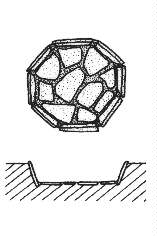
12 A typical cist of this period.
Not only is it worth while describing the living conditions of these people, but the problem of food is of equal importance. In a desert or steppe climate as the Anasazi found in the Southwest, food was probably a constant and primary concern. Basketmaker II people were not solely dependant on hunting and gathering, nevertheless they were "masters" at collecting seeds, nuts, fruits and berries. They started cultivating corn, squash and possibly sunflowers, but at the beginning of this period the yields were probably not too high and, therefore, agriculture had no high rank. As time went on, their food supply shifted and agriculture became more important until their efforts were equally divided between hunting and farming.
The early Basketmakers, those who lived before A. D. 500, were builders and farmers even though they moved around in pursuit of game. [...] As they became better farmers, the Basketmakers farmed more and traveled less.13
Most corn cultivated by Basketmaker II people was a tropical flint with small ears. They planted the kernels in a hill or in fields, which were sometimes flooded, making use of the rare water. Their agricultural implements were of very poor quality and consisted of digging and cultivating sticks, both made of wood. Some of these implements had straight points and crooked or straight handles, others had blades only. Scientists believe that the former were used for planting and breaking the soil, the latter probably for loosening the soil and weeding. Some of the cultivated corn was stored for next year's planting, for the winters and for emergency use in case of crop failures. Despite the abundance of vegetable and fruit, meat was an important component of man's diet. Basketmaker II people hunted smaller animals such as rabbits, badgers, prairie dogs and birds, as well as larger animals such as deer, mountain sheep and mountain lion. The smaller animals were hunted with nets and snares mostly, made of woven hair, cords and an apocynum mixture, colouring the nets and snares darker. Sizes of such traps vary, some of the nets, though, have a size as big as a tennis net.
Largest of the game traps identified with the Basketmakers is a net like those used on our tennis courts, but much longer. One found in White Dog Cave is 240 feet long and nearly four feet wide, with a two-inch mesh of fine fiber string. It weighs 28 pounds and has nearly four miles of cordage in its meshes. 14
The larger animals were usually hunted with an atlatl.

15 This picture illustrates what an atlatl looked like.
An atlatl comprises a stick, about two feet long, an inch wide and about half an inch thick. In this stick there is a curved spur at the one end to engage a spear, and a pair of leather finger loops, at the other end, to afford the user a firm grip. Two fingers, either the second and the third or the first and the second, were passed through these loops, the other fingers held the dart in the right position. Usually, there are one or more stones whipped to the atlatl somewhere between the finger loops and the spur. The purpose of these stones probably was to give the weapon a better balance, but they may also have served as good luck stones or charms, as these stones were highly polished. The spears and the darts used with an atlatl are made in two parts, a long main shaft and a short foreshaft.

16 A spear or dart used with an atlatl.
The foreshaft was made of hardwood, had an attached stone point at one end, and was slightly pointed at the other end. The main shaft was made of a lighter wood and had conical holes, which were drilled at both ends. One of these ends, which was usually feathered, fitted into the curved spur of the atlatl while the other end was used to insert the pointed end of the foreshaft. This made the foreshaft detachable and therefore prevented the loss of an entire spear or dart, while removing it when the fore part was buried in an animal's body. Thus, a Basketmaker II man could use a single spear for several shots. The atlatl acts on the principle of a lever, by lengthening man's arm in order to throw the spear at a higher speed, enlarging the power and the distance of a shot.
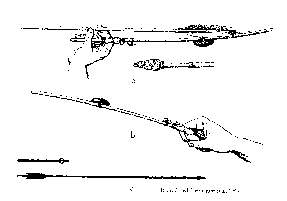
17 This illustration shows how an atlatl was used.
Besides the atlatl there existed grooved throwing or fending sticks, which are sometimes referred to as "rabbit sticks". They are from two to three feet long , with longitudinal parallel grooved lines from the hand grip to the end.

18 This is an illustration of a rabbit stick.
These sticks may have served for several purposes. The most common idea, and this is where the term "rabbit stick" comes from, is that these sticks were used to hunt rabbits, in the same way as many other tribes such as the descendants of the Anasazi, the Hopi, do. The sticks were thrown somehow like an Australian boomerang, but without the return feature, in order to hit a rabbit. Another purpose is that these sticks might have served as fending sticks in conjunction with an atlatl. A dart or spear thrown with an atlatl moves fairly slowly and could probably be deflected by the skilful use of such a stick. This theory sounds misleading, as one might think that the Basketmakers were warlike, which was not the case, but surely there were fights, among each other and against aggressive nomads. Two other weapons the Basketmaker II people knew were knives, which normally only existed of stone blades, and grooved axes which were quite rare. As true pottery was not yet known to Basketmaker II people - only unfired clay-vessels, which will be described later, were known - the most distinctive feature of the Basketmaker Culture, as it is insinuated by their name, was the making of basketry and other fibre fabrics such as bags and sandals. Basketmaker II people were able to produce baskets by applying two techniques, coiling and twining.
Most baskets were made by the coiled technique in which a basket is built up from the base by a growing spiral coil. As the baskets progress, each coil is sewed to the one below with a thin splint. The coil itself consists of two rods, usually willow, and a bundle of fibrous material. 19
Some baskets, especially the larger and cruder ones, were made of the twining technique. Here, radiating rods formed the basis of the vessel. Around these rods splints or other rods were interwined. Such a basket had a coarser structure than baskets made by the coiling technique.
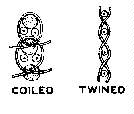
20 This picture shows two of the major weaving techniques.
Basketmaker II people made baskets for every occasion. Shallow trays were the most common form, but there were also bowls, deep carrying baskets, water baskets, small baskets for storing trinkets or other valuable objects, and large flexible baskets. Water-carrying baskets are probably the most interesting, as everybody knows that a basket normally does not hold water. These water-carrying baskets were very tightly woven and lined with pitch made of pinyon gum. They have smaller constricted openings than the other baskets to prevent the water from splashing out. Two loops, one at each end, which were attached to the basket, formed a base to which ropes were fastened. The basket was raised to the back and a tump strap was raised high across the forehead.

21 A tump strap.
Such a tump strap was also used with other carrying baskets and allowed the Basketmaker II people to carry a heavy basket on their back, having their hands free, letting them move more freely. Another interesting thing about baskets is that they were also used for cooking. As I mentioned above, the baskets were lined with a pitch, which let them hold water. Even though they could hold water, the problem remained as to how it could be heated, since these vessels obviously could not be subjected to fire. Thus, the Anasazi heated stones in a fire and dropped these hot stones into a water filled basket. This procedure had to be repeated several times until the required temperature was reached. Basketmaker II people used skin receptacles in the same way as baskets for cooking. Though these men were able to heat and cook food, this method was inefficient and greatly limited the cooking possibilities. Apart from making baskets, the Basketmakers were masters of producing sandals. These sandals serve well for archaeologists as they changed during nearly every period, thus showing the development of a culture. The Basketmaker II people produced two different types of sandals, one which had a very fine weave and was made of cord, the other of a coarser weave made of twisted, shredded or whole yucca fibres and apocynum, Indian Hemp. Basketmaker II sandals have a more or less square toe, some of them have a buckskin or fibre fringe, others do not. Both sandals had two loops, one for the toe, the other for the heel. These toe-loops and heel-loops were usually "connected" with a tie-string, which itself was put around the ankle. Scientists hold the opinion that coarse sandals were either for general wear, or, which I agree with, were worn as a sort of overshoe in case of bad weather, as these shoes were often found coated with mud. Other clothing probably was really rare, as far as scientists can reproduce this point because most of this perishable material withered away. From items found in dry caves or on the bodies of mummies, though, scientists learned about the clothing habits of the Basketmaker people. Some "aprons" have been found, believed to have been worn by women. They consisted of a waist cord to which a fringe of strings, made of cedar or yucca fibre, was attached. Long hanks of string or fibre were also found, a fact from which scholars deduce that they were tucked under the waist cord at front and rear and served as menstrual pads. Men's clothing probably consisted of a G-string in addition to sandals. These G-strings were made of yucca fibres, looped over and attached to a cord. The cord went around the waist and the fibres were drawn down between the legs and up the back to be looped over the cord. Since the country in which these people lived has very cold winters, and even the nights during the other seasons are not too warm, there certainly must have been some covering which gave them warmth. Scientists discovered blankets made of rabbit fur, which were constructed in an ingenious way. Strings were made of yucca fibres. Around these man wrapped narrow strips of rabbit fur. These fur covered yucca strings were then tied together in close parallel rows, producing a light, warm fur blanket.

22 This illustration shows how a blanket was made.
Basketmaker people also produced two types of robes, one made of rabbit fur in the same manner as described above, the other made of tanned deerskin. These robes were sometimes provided with leather tie-straps, which held the robes across the chest. Skulls of Anasazi are of high interest as they changed their posterior form over the periods. This is, because, on the one hand, the cradles used by the Anasazi people during the Basketmaker periods, were made of light material and padded with soft material such as shredded juniper bark and tanned mountain skin, and, on the other hand, were made of harder material which was not softened during later periods which is the cause for skull deformation.
The Basketmaker III Period began at about 500 A. D. and lasted till about 700 A. D., again depending on the region. After several hundred years of slow advancement during the former period, Basketmaker III people more and more began to abandon their semi-nomadic way of life, as a matter of increasing dependence upon agriculture. The Basketmaker III period can be characterised as a period of major change for the Anasazi, as they changed their habits rapidly, making use of the various "inventions" and constructions. While Basketmaker II people mostly lived in caves or rock shelters, Basketmaker III people began to construct permanent semi-subterranean houses, referred to as pit houses. These pit houses seem to have been an evolution of the cists of the preceding period, for many of them are little more than elaborated large cists with roofs.

23 Cutaway view of a pithouse model.
The houses were not contiguous to one another, but were normally built close together, which indicates that, on the one hand, the population had grown and, on the other, that family life or better social life became more important. Early pit houses were more or less circular in shape, later they became more oval and, eventually, a rectangular form prevailed. Almost all of these pit houses consisted of a large living room and a small antechamber which usually served as a storage facility. The depth of such a house varied from three to five feet and the diameter of such a structure ranged between nine and twenty-five feet. The pit walls were sometimes clay plastered, in looser soil, though, they were lined with stone slabs, onto which occasionally a few rows of adobe bricks were placed. The wainscot of a pit house in some cases consisted of a combination of slabs and plasters, in others poles or reeds covered with mud formed it.
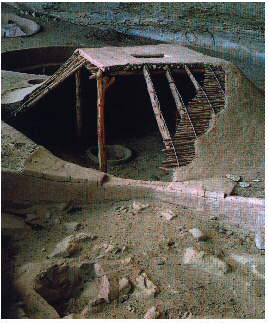
24Reconstruction of a pithouse clearly illustrating the roof construction .
The pit was covered by a conical or truncated superstructure with a hole in the centre, letting the smoke from a fireplace within the pit house below escape. The basis of the superstructure was formed by four posts, embedded in the floor, and supporting a platform of horizontal timbres. Smaller timbers or poles, which, too, were set into the ground, leaned against the platform, and others were laid horizontally across it. Mats and brush, which were finally covered as well with a layer of plaster and earth, reinforced with twigs, grass and bark, covered the whole construction making it weatherproof. Besides this type of roofing, two other types existed, which were not very common, though, and therefore, from my point of view, do not need any explanation in an essay like this. The early pit houses were usually entered through a low passageway. Ventilation was provided by a hole in the roof, which later became the entrance to the room below, by using a ladder for access. The side entrance was retained in reduced form to afford additional ventilation. A flat stone was placed in front of this ventilation shaft, serving as a deflector, keeping the inrushing air from putting out the fire in the fire pit, which itself was located in the centre of the room.
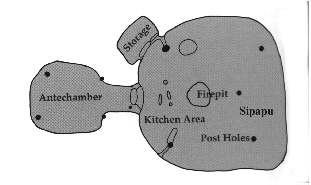
25 Floor plan of a pithouse.
Starting on the south side of the fire pit, extending to the walls there were often ridges of mud, which were later replaced by partitions made of stone or adobe, dividing off a cooking or women's area from the rest of the house. Scientists believe this as many manos and metates, utensils used for grinding , work usually done by women, were found in this section of the house. On the other side of the fire pit, scientists discovered a small hole in the floor, known as the sipapu.

26 Typical basketmaker trough - metate and mano.
Present day Indians still have such a sipapu in their ceremonial structures, so scientists postulated that the function or purpose of this hole in Basketmaker times was likely the same. The sipapu represents and probably represented a symbolic opening to the underworld, which is of great importance, as according to legend, the first people entered earth from the underworld. Originally, probably every Basketmaker III house had its own shrine, in later periods, though, highly specialised structures were built for ceremonial purposes. It was also at this time when the diet of the Anasazi people changed radically as beans were introduced. These beans contained much protein, especially an amino acid called lysine which lacks among the proteins in corn, and, therefore, were probably welcomed by Basketmaker people. The appearance of these crops is also evidence of a more settled life, as beans require almost constant attention. Besides the introduction of beans, the bow and arrow started replacing the atlatl. The arrival of the bow and arrow is proved by the finding of arrow butts, which did not have the usual drilled hole, evidence for the fact that they were used with an atlatl, but had grooves instead, indicating that they were used with the string of a bow. The bow and arrow made game easier to kill and therefore enlarged the quantity of meat. During the Basketmaker III period, the Anasazi had the four staples of food which the early Indians of the Southwest are famous for and which would serve them for hundreds of years: meat, corn or maize, squash and beans. Besides these important changes in everyday life, the idea of making pottery, too, came to the Anasazi. Scientists believe that all these changes were the result of contact and trade with neighbouring cultures, pottery making, for example, is believed to have come from Mexico by trading with the Mogollan and the Hohokam people. Pottery was probably the most important invention as it allowed Basketmaker people greater freedom of movement - vessels made of clay were used to carry water - and a more effective way of cooking, because they were not any longer dependant on using hot stones with baskets, but could use clay made vessels instead. The first pottery, which already appeared in the previous stage, the Basketmaker II stage, was no true pottery. Basketmaker II people and then the later Basketmaker III people, especially the women, started to smear mud on the inside of their baskets in order to keep out the rodents. As a matter of fact they were pleased with the idea of "clay-containers" and tried experimenting a lot. They discovered that plain mud would stick to the side of baskets as long as it was wet, but as soon as it began to dry the adobe, a dense, heavy clay that occurred and still occurs in many places in the Southwest, cracked and chipped and finally started falling off the basket. So, as time went on, the Anasazi tried mixing a little bit of this and a little bit of that with the adobe and soon found out that sand was the best substance to mix with the clay. Furthermore they learned to lift the dried mud shells out of the baskets which they had been formed in. With all these improvements though, Basketmaker III people still did not have true pottery as they did not yet know that firing would prevent the bowl from "melting away" if it got wet or slightly damp. How the Anasazi finally discovered the skill of baking their clay-made bowls is still a mystery for which scientists have numerous theories.
How the women learned to bake their bowls is still a mystery. Archaeologists once thought that perhaps there was a house fire which destroyed everything the family owned except the mud linings in some of the baskets. When the flames died down and the ashes of the roof and wall supports cooled off, the first pottery bowls were found in the ruins and were discovered to be waterproof. [...] Another explanation is that pottery, like weaving and cotton and corn, came to the Anasazi from Indians living to the south of them.27
I agree with the theory most scientists believe in that knowledge of making pottery came to the Anasazi from neighbouring cultures. In any case archaeologists have found every stage in development of pottery in sequence, starting with the thick, unfired mud storage jars, conceding with the crude fire-baked bowls and jars, and ending with the fine and thin very beautiful decorated wares. The first Basketmaker III pottery was either moulded or started in a basket and finally finished by a coiling technique.
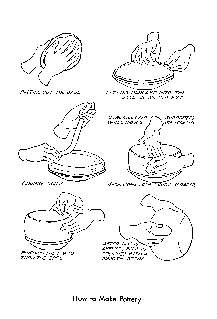
28 How to make pottery.
To produce a vessel by this method, a thin rope of clay is formed and then wound around in a circle, each row or coil being attached to the preceding one. In some cases, if a smooth surface was desired, the depressions which mark the joining of the coils was obliterated, making use of a gourd or wooden scraper. Pottery was crude and quite a lot of globular forms such as gourds and baskets occurred. Perforated side lugs were a characteristic trait of Basketmaker pottery. The prevailing ware was a light to medium grey with a coarse granular paste tempered with quartz, which sometimes became black from smoke carbon. The exterior of the vessels was occasionally rubbed with a brush of grass or other fibres, while still wet, leaving a striated form. Bowls were sometimes decorated on the exterior, some even on the interior. These decorations were applied with black paint, which is believed to have been made out of pods of guaco, the Rocky Mountain bee plant. In order to achieve the black colour the Anasazi boiled the bee plant until it made syrup, painted designs on the pots with it and, then, finally after having fired the bowl the syrup had burned or better carbonised to a black colour. The designs, which covered the bowls, usually consisted of bands or ribbon-like panels, the most common elements being dots rake like appendages, crude life forms and triangles. The Anasazi made their paintbrushes out of fine, dry yucca-leaf-ribs. They chewed the one end of such a yucca-leaf-rib until the fibres separated and were soft and flexible, leaving the other end stiff, forming a perfect handle. Fired pottery was made in two ways, either in a reducing atmosphere, there is no excess of oxygen in the air in which the pottery is fired, or in an oxidising atmosphere in which the air is allowed to circulate allowing the excess of oxygen. Basketmaker wares were usually fired in reducing atmosphere colouring the vessels white or grey, whereas an oxidising atmosphere would colour the vessels red, brown or yellow. Again, besides pottery, a very characteristic feature of this culture stage is the manufacture both of very fine sandals and tump straps. Two types of sandals were made, some for everyday life and much finer dress sandals, which are of particular interest as they were not square toed but had a crescent portion left out of the toe, therefore giving these sandals the name "crescent toe" or "scalloped" sandals. These sandals were coloured and designed in an ingenious way, serving quite well in such a harsh environment, which required a good footing. Turning to the point of clothing, one can say that clothing all in all improved during Basketmaker III times, although the Anasazi still wore only few things. The number of animal skins increased, because more animals could be obtained with the bow and arrow. Blankets and robes were still produced of rabbit fur, turkey-feather-blankets and robes made of turkey-feathers and yucca fibres got more and more important, as a consequence of the domestication of turkeys. Skulls of Basketmaker III people were, as well as the skulls of the former period, not deformed.
Top
|
|














